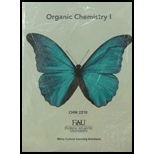
Concept explainers
The synthesis of cyclobutanecarboxylic acid given in Section 18.7 was first carried out by William Perkin, Jr., in 1883, and it represent-ed one of the first syntheses of an organic compound with a ring smaller than six carbon atoms. (There was a general feeling at the time that such compounds would be too unstable to exist.) Earlier in 1883, Perkin reported what he mistakenly believed to be a cyclobutane derivative obtained from the reaction of acetoacetic ester and 1,3-dibromopropane. The reaction that Perkin had expected to take place was the following:

The molecular formula for his product agreed with the formulation given in the preceding reaction, and alkaline hydrolysis and acidification gave a nicely crystalline acid (also having the expected molecular formula). The acid, however, was quite stable to heat and resisted decarboxylation. Perkin later found that both the ester and the acid contained six-membered rings (five carbon atoms and one oxygen atom). Recall the charge distribution in the enolate ion obtained from acetoacetic ester and propose structures for Perkin’s ester and acid.
Want to see the full answer?
Check out a sample textbook solution
Chapter 18 Solutions
ORGANIC CHEM.I-W/STD.GDE.+...>CUSTOM<
Additional Science Textbook Solutions
Chemistry: A Molecular Approach
General, Organic, and Biological Chemistry: Structures of Life (5th Edition)
Organic Chemistry As a Second Language: Second Semester Topics
Chemistry: The Central Science (14th Edition)
Chemistry & Chemical Reactivity
Introductory Chemistry (6th Edition)
- The hydrocarbon fluorene was treated with potassium t-butoxide in an acid-base reaction, giving the fluorenide anion and t-butyl alcohol. (a) Which way does the equilibrium lie, and by how much? b) What is the proportion of the fluorenide anion to fluorene? (c) Why is fluorene so highly acidic, considering the pKa of an average alkane is above 50?arrow_forward(a) Tsomane and Nyiko were given a task of synthesising methylenecyclohexane 2. After a brief discussion with each other, Tsomane proposed Method A to synthesise 2 from cyclohexanone 1 while Nyiko proposed Method B that started from hydroxymethylcyclohexane 3. Each student believed that their proposed method is better than the other. (Scheme below) Ph THF A Ph Ph B H₂SO4 100 °C 3 OH (iii) In analysing both these methods, are there other possible alkene products other than methylenecyclohexane 2? Use mechanistic details to support your answer.arrow_forward4) Aromatic compounds are among the most abundant and versatile in nature. From a synthetic point of view, these compounds, despite their stabilities, are quite useful and can undergo reactions under special conditions and by specific mechanisms, such as the Electrophilic Aromatic Substitution (SAE) and the Nucleophilic Aromatic Substitution (SNAr). Based on this, please answer the following items: (b) How would you prepare the following compounds starting from benzene? Explain the second in a different wayarrow_forward
- An aromatic hydrocarbon with a molecular formula of C13H20 has an 1H NMR spectrum with a signal at ~7 ppm that integrates to 5H. It also has two singlets; one of the singlets has 1.5 times the area of the second. What is the structure of the aromatic hydrocarbon?arrow_forward(a) Tsomane and Nyiko were given a task of synthesising methylenecyclohexane 2. After a brief discussion with each other, Tsomane proposed Method A to synthesise 2 from cyclohexanone 1 while Nyiko proposed Method B that started from hydroxymethylcyclohexane 3. Each student believed that their proposed method is better than the other. (Scheme below) (1) Ph Ph 8*8 Ph THF A 1 Santande B H₂SO4 100 °C 3 OH Using curly arrows, provide full mechanistic details accounting how methylenecyclohexane 2 was synthesised according to both Methods A and B.arrow_forwardWhen we have discussed the enol-keto tautomerization of ketones in class, the isomerization has been facililated by an acid or base catalyst, with most ketones heavily favoring the carbonyl isomer at equilibrium. However, samples of the ketone below in its pure form (with no acid, base or water present) contain nearly 10% of the enol form! OH -90% -10% From this data, we can infer that the enol isomer of this ketone is particularly stable. Explain the stability of this enol, using terms and ideas that we have discussed in this unit.arrow_forward
- 6. Describe concisely a chemical test to distinguish between the following pairs of compounds. Terangkan secara ringkas ujian kimia bagi membezakan pasangan sebatian berikut. (a) Propanal and propanone (b) Phenol and benzoic acid (c) Hexan-3-one and hexan-2-onearrow_forward(b) The activating and deactivating groups could affect the position(s) of the next incoming group(s) to the benzene ring. Based on the structure below, analyze and explain the group(s) on the benzene ring is activating or deactivating group. Then, identify the product(s) formed from the following reactions. NH, CC, CH;CH,COCI AICI, (i) NH, HNO, H,SO, (ii) H Br AICI, (iii) Page 3 of 4arrow_forward(a) Which of the following will NOT produce a carboxylic acid or carboxylate ion? 1-butanol + H2CrO4 2-butene + O3/H2O2 butanal + PCC butanal + H2CrO4 (b) Which of the following will NOT produce a carboxylic acid or carboxylate ion? 1-butanol + H2CrO4 2-butene + O3/H2O2 butanal + PCC butanal + H2CrO4arrow_forward
- 9. Plan syntheses of the following compounds. You may use the given starting material and any compound containing three or fewer carbons. (a) (b) (c) (d) by Br or Br H Br H OH = OHarrow_forwardThe formate and methoxide ions are both formed by removing a hydrogen atom from a corresponding neutral compound. Given that each process involves the breaking of an O-H bond, explain why the formate ion is so much more stable than the methoxide ion.arrow_forward
 Organic ChemistryChemistryISBN:9781305580350Author:William H. Brown, Brent L. Iverson, Eric Anslyn, Christopher S. FootePublisher:Cengage Learning
Organic ChemistryChemistryISBN:9781305580350Author:William H. Brown, Brent L. Iverson, Eric Anslyn, Christopher S. FootePublisher:Cengage Learning

